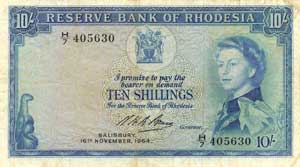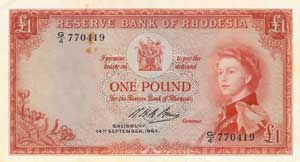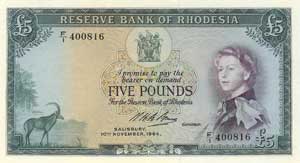Banknotes and Bureaucratic Bungling

In October of 1965 both Rhodesia and the English banknote printing company Bradbury Wilkinson & Co. (BWC) received an order to print more banknotes for the Salisbury based board of the Reserve Bank of Rhodesia after successfully printing notes for them in 1964.



Original 1964 series of Rhodesian paper money printed by Bradbury Wilkinson & Co.
The order was for £20 million worth of banknotes consisting of 8 million 10 shilling notes, 11 million £1 notes, and 1 million £5 banknotes. The notes were due for delivery second quarter of 1966.
However, on November 11th of 1965 Rhodesia declared independence from Great Britain. On December 3, 1965 the London government moves swiftly to remove the Salisbury board and replace it with one in London. Meanwhile the Salisbury based board continues to operate under the new Rhodesian Government.
The London board allows BWC to fill the order for the banknotes already on order. BWC does this and has the order ready in May 1966. The Salisbury board refuses to pay BWC as it had independently placed an order on April 7 of 1966 with the German printer Giesecke & Deverient (G&D) for a completely new range of banknotes.
A court Injunction prevented G&D from supplying the notes to Rhodesia and they were subsequently destroyed by the printer, in their entirely. No details were ever released as to the designs, denominations, or even colours of this destroyed batch of banknotes. The British government would not give BWC an export licence to ship their notes to Rhodesia either. In turn they were sent to the Bank of England for storage and when they were no longer needed (July 1973) they were all destroyed - save one 10 shilling specimen dated November 5 1965.
Unable to get any notes from a secure printer the Reserve Bank took it upon itself to produce banknotes on their own printing presses. The notes (p27, p28, and p29) are similar to the 1964 series with minor modifications that were done to the Queens portrait, a change in the colour of the serial numbers, and colour changes to the vignettes on the reverse side of the banknotes. Lastly, the dates were repositioned on the notes. These note circulated in parallel with the 1964 series.



All subsequent paper money of Rhodesia was printed by the country's own printing presses, including the second issue which was much like the first. Rhodesia continued to print its own banknotes until it became Zimbabwe.
With the success of this self printed series, dated 1966-1968, when the bank made the switch over to the decimal system in 1970 it looked no further than itself to produce these notes as well. This continued up to 1979 when Rhodesia became Zimbabwe in 1980 and Salisbury was subsequently renamed Harare.
It just goes to show if you want things done right sometimes you have to do it yourself!





